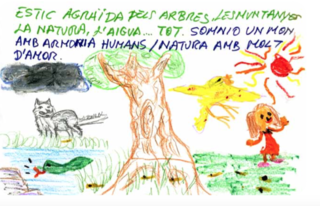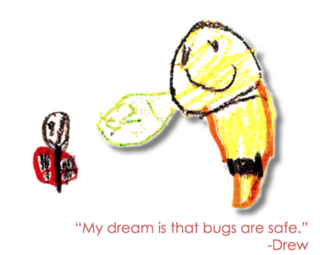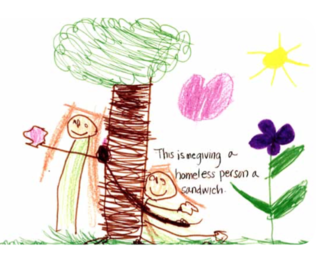Environment
Easy Ways to Connect Kids to Animals, People, and Nature
Some simple practical tips for how they can express their hopes and dreams.
Posted March 30, 2020

Looking to youngsters for words of wisdom about other animals, other humans, and nature
Many, if not most youngsters enjoy being outside in the presence of other animals or just running around and enjoying their freedom to "be kids." Many are inherently and intuitively curious naturalists. They're sponges for knowledge, absorbing, retaining, and using new information at astounding rates.
We surely don't need any more data to support what just about everyone knows, fully recognizing that for one reason or another some kids would rather be holed-up indoors sitting on their butts doing little or nothing. However, it's likely that many of them also could be motivated to get outdoors and to express their feelings about other animals, people, and nature with the right guidance.
Given all sorts of global lockdowns, I'm hearing stories from parents that they're going nuts trying to figure out how to engage their kids and to allow them to speak their minds, and in some cases, their hearts, about their feelings for nonhuman animals (animals), often the companion animals with whom they live, and others about whom they know or would like to know more.
In a number of conversations, both in-person and via email, I've been asked something like, "What can my kids do to engage themselves?" or "What can I do to allow them to speak their minds?" I immediately thought of a project I did in a number of different countries. When I explained how simple it is to do, many people told me they would try it. And, I'm pleased to say many have told me "it worked." Their kids are really engaged and talking with one another and with adults in person or on various social web-based platforms.
Pencils and paper are all you need
The project about which I told them is one I've done as part of Jane Goodall's global Roots & Shoots program. It's based on asking kids to fill in the blank for two statements: "I have a dream that _____" and "I am thankful for _____" and to draw a picture representing what they wrote. You can see many examples of how kids in numerous countries responded in a book that's available online for free called kids & animals: drawings from the hands and hearts of children and youth. The idea for this book originated in my hometown of Boulder, Colorado, when Ellen Mackey, a teacher at Foothill Elementary School, organized a Roots & Shoots group for her third-grade class using Dr. Martin Luther King’s “I Have a Dream” speech as her model. What's also interesting about these gatherings is that adults also wound up partaking. It's fun for all. All you need to do this project are pencils and paper. And I know you'll love what you see.
As we worked on the organization of the book, we saw five different sections emerge: Safety; Peace; Love, Caring, & Families; Homes & Habitats; and Coexistence & Cooperation. The final section, Celebration, reminds us to notice the wonders of the living world, to play, and to appreciate our opportunities to make the world a better place for all beings, nonhuman animals and humans alike.
Some examples of what the kids wrote and drew

kids & animals truly reflects the spirit of Roots & Shoots, namely that every individual can make a positive difference in the world and that we all need to work together to foster respect, appreciation, empathy, and compassion for animals, people, and the environments we all share. It is perfect for classes, discussions, and activities focusing on humane education and conservation education.
The project also crosses cultures, both globally and within communities. In kids & animals you'll see examples of youngsters dreaming of peace. In one project Dr. Goodall and I did at an inner-city school in Denver, the students were experts on the ecology and behavior of rats. I remember when I asked a few of them why this was so, they told me that rats were the only animals they routinely saw and really knew and they decided to learn as much as they could about them. However, I also learned that many of them were experts on the behavior of dogs, cats, and people.
It's essential to connect kids to other animals, other people, and nature and learn from what they're feeling

We must teach the children well and celebrate our magnificent and fascinating world and how we can make the world a better place for all beings. I hope readers will work closely with their kids in an activity such as this and join in on the fun. These are extremely challenging times for all.
I get a lot of hope and inspiration from the interactions I have with youngsters, and I encourage others to talk with them and learn about what they're thinking and feeling about the state of the planet and also to learn about what they're thankful for and dream about.
Clearly, people working to help animals and humans are not alone; there is a large international community aspiring to these goals. Discussions about what the youngsters write and draw are incredibly insightful and serve to connect them to other animals, other people, and other nature, often half a world apart. And every individual can make a positive difference by doing simple things. We can look to youngsters of all ages for ideas about how we can expand our compassion footprint.

It's impossible to emphasize too strongly the importance of positive messaging and getting kids to express how they feel—to empower them, give them agency, and to listen to what they have to say. I'm sure this will have long-term effects on how they view other animals, other people, and other nature.
As examples of what you'll find in kids & animals, Autumn's, Anisia's, Drew's, and Mia's drawings and words say it all. And, there's much much more—numerous wonderful drawings and deep, rich words of wisdom that'll keep you and your kids busy for days and weeks on end. So get out the pencils and paper and get going on what will be a win-win for all.
References




